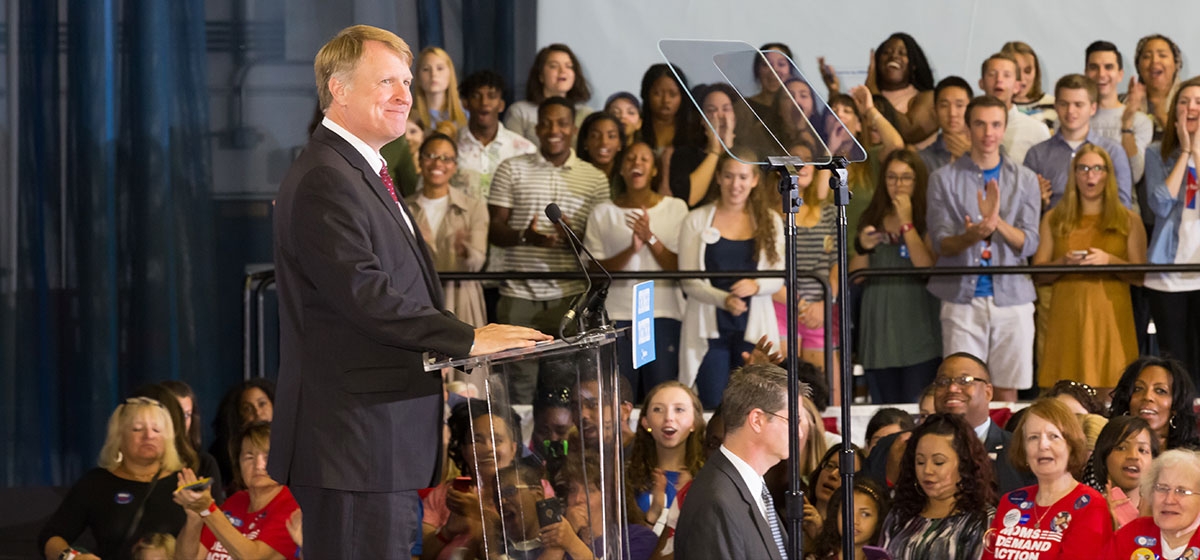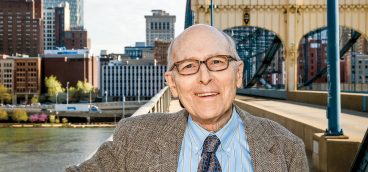Rich Fitzgerald, Allegheny County Executive

I was born and raised in the Bloomfield-Garfield section of Pittsburgh, which is now called “Friendship.” I attended St. Lawrence O’Toole Grade School in Garfield, Central Catholic High and then Carnegie Mellon University in nearby Oakland, and have lived and raised my family in Squirrel Hill for the past 33 years. So, geographically speaking, I’ve stayed within a few miles of where I was born. Pittsburgh is my home. My family roots go deep.
Both my mother’s and my father’s families were from Bloomfield. My grandfather on my father’s side was a salesman, as were my father and uncles. I learned some of what I know about communicating with people, and understanding their issues and concerns, from that side of the family. My grandfather on my mother’s side was a butcher on Fifth Avenue in Uptown by day and, at night, he worked as an usher at both Forbes Field and Pitt Stadium. I learned a lot about the value of hard work from him. Both my mother and father ingrained in me a strong work ethic, as well as a love and enthusiasm for this city. So, I grew up in a typical Pittsburgh family and had no desire to leave.
In the late 1970s and early ’80s, the contraction of the steel industry in Pittsburgh affected us all as many businesses and jobs started to leave town. When I graduated from Carnegie Mellon in 1981, I had several job offers, but none near home, so like many Pittsburghers, I took a job in another city. But I always had a desire to return. I accepted a sales job with Nalco Chemical, a company that specialized in industrial water treatment, which took me to Rockford, Illinois. Since my goal always was to get back home, after only two years I decided that, if there wasn’t a job for me in Pittsburgh, I would create one. With that, I decided to move back and start my own business in my hometown.
Using my engineering knowledge and industrial experience, I began calling on industrial companies to show them how I could save them money on their energy bills. After a lot of hard work (and a little bit of luck), clients started requesting my services. You see, I filled a need in the marketplace that was going unfilled. It took a while to become profitable, but as a young, single individual with no family to support, I was able to live a relatively spartan-like life. As I developed a clientele in western Pennsylvania, West Virginia and eastern Ohio, I also saw that other parts of the country were doing much better economically, and heard from colleagues who were in similar businesses that, financially, I could make more money elsewhere. But my desire to stay in Pittsburgh and raise a family here kept me rooted.
My wife, Cathy, is from Greenfield and went to Taylor Allderdice High School and Pitt Pharmacy School. We met when we were in college—Cathy at Pitt and me at CMU—and began dating. Like me, she also had more financially lucrative opportunities to leave Pittsburgh, but decided to start her pharmacy career here as well. As we began our life together in Pittsburgh’s Squirrel Hill neighborhood and started our family, we were fortunate that it was a great place to raise kids. Over time, we were blessed to have eight healthy children who grew up in this community and, other than outgrowing our first house and moving into our second, we pretty much stayed put.
As our kids were growing, Cathy and I worked a lot, and I really didn’t have much time or interest in local politics. I had no background in government and no one in my family had ever been involved in the political process. But then, in the early ’90s, when my kids started going to public school, Cathy and I got involved in lots of different neighborhood and school issues. For example, we addressed some zoning problems on our street. We also helped to build a playground at our kids’ school, Liberty. And as I immersed myself in these issues, I found that I enjoyed it. We learned that we had to communicate with the elected officials who had the power to make changes, or the resources to fund projects, and we worked with them to gain their support and commitment.
At the same time, I was growing frustrated by the fact that so many Pittsburghers were leaving town. Members of my own family, as well as many friends and neighbors who grew up here and graduated in the ’80s and early ’90s, were moving away. There weren’t enough good jobs or opportunities to keep young people here. I came to the conclusion that Pittsburgh, and all of western Pennsylvania, simply had to develop sound business and economic policies that would allow local businesses to thrive and attract other ones to the area. This, more than anything else, propelled me into the world of public policy and politics.
“I came to the conclusion that Pittsburgh… simply had to develop sound economic policies that would allow local businesses to thrive and attract other ones to the area. This, more than anything else, propelled me into the world of public policy and politics.”
—Allegheny County Executive Rich Fitzgerald
At the same time, civic leaders were talking about changing the form of government in Allegheny County. It was obvious that the present system—with three commissioners running our county—wasn’t working. When businesses tried to make a deal with our government leadership, it was confusing as to who was really in charge, so outside entities tended to stay away. It also became evident that, as our population was shifting into the suburbs, a city-dominated county commissioner system wasn’t representative of the population it was serving. A new form of government, which would create a County Council representing all communities in Allegheny County with a County Executive responsible for economic development, seemed a good way to go. I got involved with the campaign to change Allegheny County government and, while change is never easy, with a lot of county citizens ready to take a big leap, the voters approved the referendum in 1998 by the slightest of margins. In 1999, with this newly created government ready to be voted in, I decided to run for the part-time County Council seat in my district. It was a way to become partially involved in government without becoming full-time and giving up my career and family life.
Jim Roddey was elected and served as our first County Executive from 1999 to 2003. Dan Onorato followed, and served two of a possible three four-year terms. As a member of County Council who recognized the positive direction in which the county was headed, I was hoping Dan would run for a third term, and had encouraged him to do so. However, in early 2011, he decided he would return to the private sector and thus created an open seat for County Executive. After 12 years on Council, and with my children now mostly grown, I felt I could take a final step toward full-time government service and ran for the office.
Believing that the region was ready to take off, I felt that my business experience and 12 years of government service could be harnessed to move us forward. Winning the job and being County Executive takes a tremendous amount of work and energy. One must engage all the components of a diverse county. Urban dwellers, suburban commuters and rural residents all have one thing in common: the desire for a great place to live and to raise a family. I found that no matter where I went or with whom I talked, love and affection for this region was strong.
On Council, most of the votes we took didn’t break down parochially. We didn’t vote for just our districts at the expense of the rest of the county, and that spirit continues to this day and extends beyond Allegheny County. The City of Pittsburgh has seen a resurgence downtown and in its neighborhoods. Many communities in the county are also experiencing growth, but we also see some of our biggest opportunities taking place outside of Allegheny County. Southpointe in Washington County, Cranberry in Butler County and, one of the biggest economic development opportunities ever, the Shell ethylene cracker plant in Beaver County, are examples of economic growth for the region. While some may believe that our focus should be only on Allegheny County, there are impacts and opportunities for our county even when the development is outside its borders. This is the case with the Shell cracker plant as the thousands of jobs created will mean that a lot of Allegheny County building tradespeople, engineers, planners and laborers will be hired, and a lot of economic activity will be brought to the county.
As a member of County Council, I was proud to have been elected president of that body four times. In that position, it was important to adopt a broad scope of the entire county in a bipartisan way. After all, I didn’t just represent my district or, as a Democrat, my party; I was leading the entire body. Working in a bipartisan manner, the most important issue we had to address was jobs. It’s the reason that I ran, and the reason that I continue to serve. I want to make sure that there are opportunities at home, particularly for young people, so that when they graduate, they can stay local. Today, there’s a broad range of opportunities for young people that didn’t exist a decade or two ago, and that’s something of which we can all be proud.
This region has a proud history of working together. There is a great spirit of cooperation here and an idea embraced by all that we can accomplish much more together than we can separately. Pittsburghers are pragmatic and hard-working. They are well known for rolling up their sleeves and getting the work done, no matter what it may be. Our labor unions, corporate leadership, foundations, universities, small businesses and government leaders all work as a team to move this region forward. Our political leadership— that of Congressman Mike Doyle, Senate Democratic Leader Jay Costa, Senator Randy Vulakovich, Speaker of the House Mike Turzai, House Democratic Leader Frank Dermody, Pittsburgh Mayor Bill Peduto and many others—have found successes in efforts that involve all of us. That leadership includes Governor Wolf and former Governor Corbett, as both played pivotal roles to ensure that the Shell cracker plant was located in this region.
As this region continues to transform itself, the primary economic engines are our universities through their technology focus. CMU, Pitt, Duquesne, Robert Morris, Chatham, Carlow, Point Park; all of these institutions are drawing talented people to Allegheny County, and companies as well, all of which want to be near our expanding pool of skilled workers. They look to embed themselves on our local campuses so that research can be done, used and commercialized. Members of the new “millennial generation”—the very individuals who will staff these companies and grow this region—want to live an urban lifestyle, in neighborhoods like the Strip District, Uptown, East Liberty, Lawrenceville, South Side and Manchester. And as the urban core starts to thrive, we also see it spreading to previously industrial towns bordering the City of Pittsburgh, such as Homestead, Millvale and Carnegie. These nearby communities are starting to revitalize, and it’s our challenge to provide amenities that improve the quality of life for the next generation.
Regardless of who’s in the White House or controlling policy in Washington or Harrisburg, the change in our economy is coming faster than many of us realize. No one can stop it and, no matter who’s in charge, our challenge is a local one. If kids who grow up here don’t have the right education and the right skill sets, they will not be able to make it very far in the new economy. But if they do, their opportunities will be tremendous. When people are left out of the prosperity generated in any locality, big problems arise. If they don’t have hope for the future, a sense of desperation sets in. You know, Bill Clinton’s campaign had it right in 1992 with the mantra: “It’s the economy, stupid.” And Mayor Peduto here says this all the time: “The best way to take a gun out of a young person’s hand is to put a paycheck in it.” I share that belief, too, as a parent, and as one who grew up in this community and witnessed the devastation in the early ’80s, when many thousands of steel and factory workers were put out of work. Forty-five-year-old heads of households were left out in the cold. Their ancestors had been millworkers, and they thought they would be, too. Then, halfway through their working lives, it was all taken away without a sufficient answer to the question: “Where do we go from here?”
Sure, we still make steel in the Mon Valley, as we have been for more than a century. But where, back in the day, there might have been 100,000 people working in local mills, these days, there might only be a few thousand. Any given mill may today produce the same amount of steel as it did decades ago, but with only a fraction of the workforce. The same goes for the coal mines. Even if you reopen a mine, you won’t see anyone in it with picks and shovels. What you’ll see is modern machines and a small group of people operating them via robotics, autonomous vehicles and smart phones. As a result, workers over 30 or 40 will have to be retrained to compete, and that will be a hard pill for many to swallow. Automation does and will continue to present employment opportunities, but only for highly skilled workers. So it’s our job to make sure that our residents have the right education and proper skill sets to compete for these jobs.
I like my job because it’s focused on broad community growth, and not growth just for the top 5 percent of our working population. To be successful, we must reach that young person who lives in Glassport, who is coming out of a high school that perhaps doesn’t have the advantages of Mt. Lebanon or Upper St. Clair. We must make sure that he or she has the same opportunities that others have—perhaps via subsidized training in a community college—so that he or she has the same chance to work at Google, Uber or at the Shell cracker plant. Right now, between 25,000 and 30,000 jobs remain unfilled in our region, but to get those jobs, you have to have the right education and skill sets. You can’t just show up and say “I want to work.” They’ll ask you, “Well, what can you do?” We have to make sure that they have a good answer.
Thirty years ago, Pittsburgh took an unbelievable hit, more than New Orleans did from Hurricane Katrina, and the federal government didn’t come in with a bailout for us. And it has taken a long time for us to come back, but in many ways, our ability to reinvent ourselves demonstrates the resilience of the people who live here. The transformation in Pittsburgh is already underway, and will continue to grow. We’re living in a new and different Pittsburgh now and there’s one statistic that exemplifies that more than any other. In the early ’80s, our 25- to 35-year-old workforce was one of the least educated in the nation, with the smallest percentage of college degrees of any comparable region. Three decades later, that same workforce boasts one of the the highest percentages of post-graduate degrees anywhere in the country. So in one generation, we’ve gone from having one of the least educated to one of the highest educated young workforces in America. It’s truly astounding.
Yet, even though we’re changing, we don’t want to lose the character that has made Pittsburgh, well, Pittsburgh. (And when I say Pittsburgh, I mean the region.) Great communities—McKees Rocks and Polish Hill, for example, have their own feel, and a lot of this revolves around our traditions. We must try to preserve our beautiful architecture. We can’t make the mistake of demolishing our history and replacing old, venerable structures with square, utilitarian modern ones. This is something that I, Pittsburgh History and Landmarks Foundation, and Mayor Peduto are very bullish about. We want to make sure that Allegheny County continues to have the charm and character that made it what it was and is. That’s also a part of our challenge moving forward. And we will face current challenges the same way we addressed those in our past: with optimism, hard work, dedication and a great spirit of cooperation between labor, the business community, foundations, universities and our team of government leaders. We will find success—working together.






